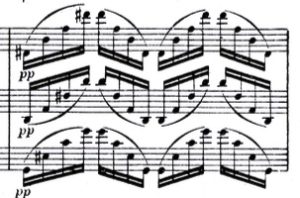And so, about Wagner’s orchestration…
 I’m back from vacation. Including two active weeks in England, where Rafa announced he’d like to stay “all day,” meaning forever. Here he is, looking at the landscape through binoculars, next to the ruins of an old barn, on a hillside.
I’m back from vacation. Including two active weeks in England, where Rafa announced he’d like to stay “all day,” meaning forever. Here he is, looking at the landscape through binoculars, next to the ruins of an old barn, on a hillside.
And yes, Wagner,
Before I get back into future of classical music things on my blog — serious stuff — I wanted to extend my vacation in my mind, by talking about some things I found in the full orchestral score of Götterdämmerung.
Maybe you remember how excited I was by Wagner’s Ring, when I saw the deep and powerful Washington National Opera production this spring. That led me to study some of the score, especially (in great detail) the second scene of the Götterdämmerung prologue, the scene for Siegfried and Brünnhilde.
One thing I noticed was how complex the music is, both in the shape and flow of the phrases (which I won’t go into here), and in the orchestration.
And very nicely, the complexity of the orchestration is easy to see in the score, even if you haven’t looked at orchestral scores before. And even — I really think this is true — if you don’t read music!
Here, to show what I mean, are two excerpts from the orchestral scores of Die Walküre, the second opera of the Ring, and Götterdämmerung, the fourth opera, written 16 years later. A moment toward the end of the first act of Walküre, and the very end of the Siegfriend/Brünnhilde scene in the Götterdämmerung prologue.
What can we see in the scores?
Both moments are exciting, propulsive, building to a huge climax (and, in the Götterdämmerung excerpt, reaching it). And both make a grand orchestral sound.
But see how simple the Walküre scene is, in the way it’s written for the orchestra! I’ve highlighted, in the score, what the winds and horns do, what the violins and violas do, and what the cellos (divided into four parts) do.
Most of the winds and horns sustain a broad three-note rhythm: ba-ba-ba ba-ba-ba ba-ba-ba, from the start of the excerpt to the end.
 The violins and violas play sweeping arpeggios, from the start of the excerpt to the end. (Don’t worry if you don’t know what an arpeggio is. The look of the score will show you better than any words what these instruments do.
The violins and violas play sweeping arpeggios, from the start of the excerpt to the end. (Don’t worry if you don’t know what an arpeggio is. The look of the score will show you better than any words what these instruments do.
And the cellos sustain long notes, from the start of the excerpt to the end.
So that’s it. Wagner sets up some patterns when the excerpt starts, and continues them mostly unchanged to the end. The sound is exciting, sweeping, rich and full, but the way the sound is produced is, in orchestral terms, pretty simple.
While in Götterdämmerung…
Now many strands in the texture have a life of their own. Wagner doesn’t score this music in broad, simple strokes. He weaves together shifting details.
At the start of the passage I’ve highlighted the violas and cellos. They don’t repeat any pattern. Instead, they trade off playing a pretty complex melodic line, which serve, as the Walküre patterns do, to fill in space behind the main melodies.
But in a much more complex way. Even if you don’t read music, you might look at the Götterdämmerung score, and see how many different things are going on.
It’s harder to write music like that. There’s much more to think of, weave together, work out the details of.
It’s harder to play this music. Each player in the orchestra has to be constantly alert, because, as they play, the meaning of what they’re playing keeps changing.
And it’s hard for the conductor, too. He or she has to learn all these details, keep them together, and keep them balanced, so the main thing you hear is the main thing you ought to be hearing.
Look at the string parts inside the big red rectangle on the second page of the score. From the top down, look at the first violins, second violins, violas, and then — beneath the two singers’ parts — the cellos and basses. They’re all playing something different. Not at all like what they do in Die Walküre. (And, once more, you don’t need to read music to see this.)
The highlights you may have seen on the final Götterdämmerung page point out other tasty Wagner details, which I’ll discuss in my next posts.
If you’d like to hear this music, here’s the Walküre excerpt, in a classic live performance from 1966, with James King singing, and Karl Böhm conducting the Bayreuth Festival Orchestra. And here’s Götterdämmerung, with Birgit Nilsson and Wolfgang Windgassen, again live from Bayreuth, with Böhm conducting,
Coming, more tasty things in the Götterdämmerung score:
An explosion of six harps. (But can anyone hear it?)
Words that might mean “go faster.” Or might not! Wagner isn’t being clear at all.
